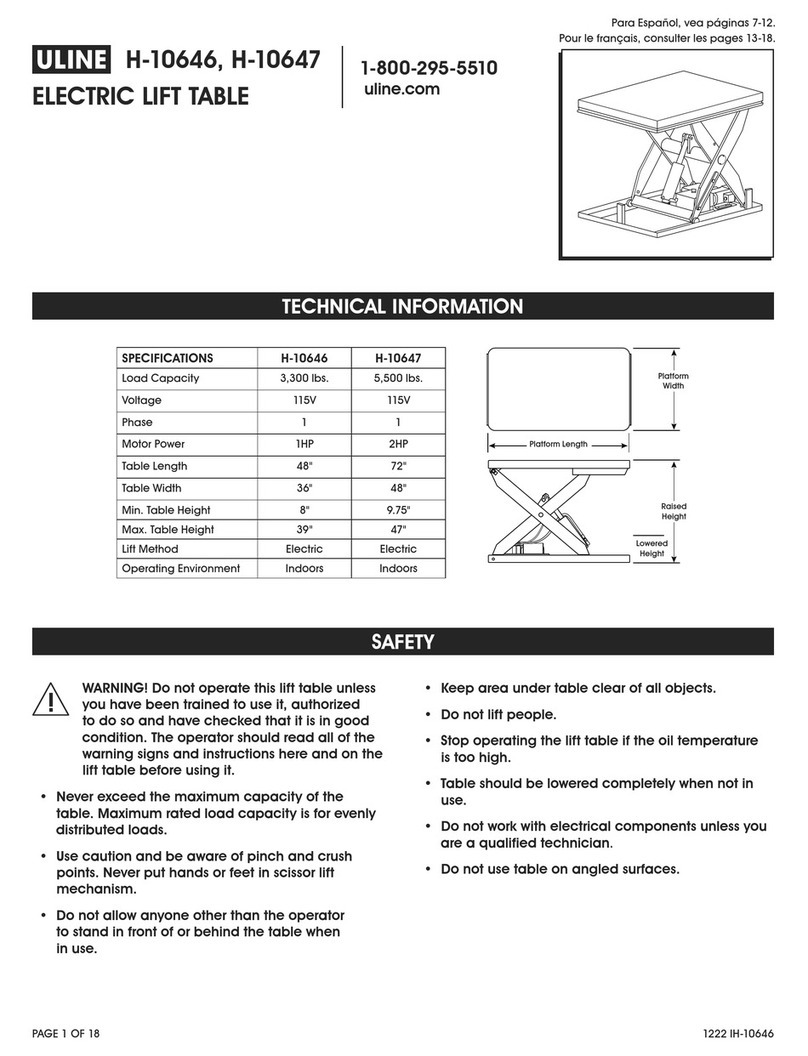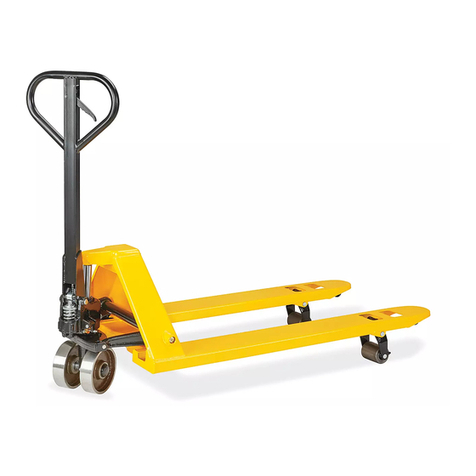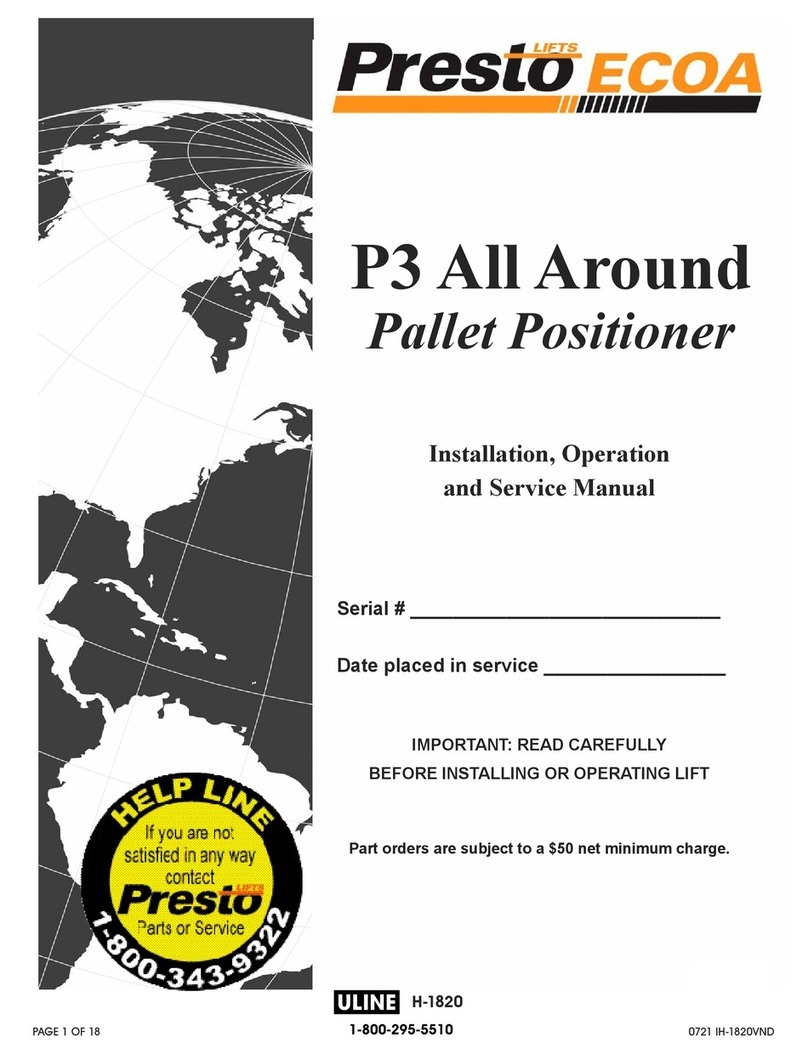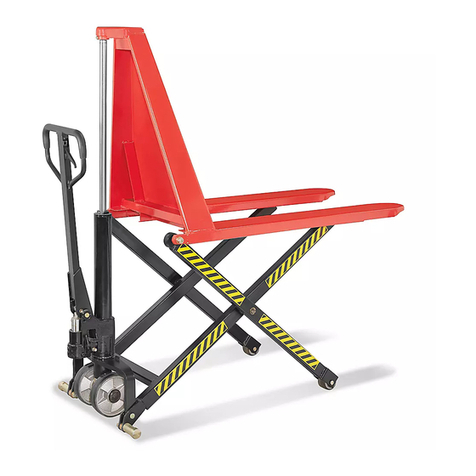
PAGE 6 OF 7 0413 IH-3934
MONTHLY INSPECTION AND
MAINTENANCE
1. If the lift is equipped with an accordion bellows skirt,
lift the bottom of the bellows skirt and secure in the
raised maintenance position with the maintenance ties.
2. ALWAYS engage the maintenance bars and ensure
the scissors mechanism is securely blocked in the
raised position before performing ANY lift inspection
or maintenance.
3. Inspect snap rings and roll pins at all pivot shaft and
axle locations. If not in place and/or secure, replace
or repair at once.
4. Inspect the scissors rollers, cylinder pivot pins,
cylinder bushings, scissors pivot pins and scissors
bushings for signs of wear. If worn, replace at once.
All pivot locations have lifetime lubricated bushings;
therefore, they do not need grease or lubrication.
5. Inspect the hydraulic power unit and cylinder for
signs of leakage. The presence of a small amount
of fluid around the cylinder rod is normal. However,
fluid flowing from around the top of the cylinder
head cap indicates worn seals. Replace the
cylinder seals at once.
6. Inspect the hydraulic lines for chaffing and sign of
wear. If worn, replace at once.
7. Inspect the hydraulic line connections for tightness.
Tighten if necessary.
8. To check the level and appearance of the hydraulic
fluid (See Figure 7) raise the unloaded platform
and engage the maintenance bars. All lifts are
equipped with translucent plastic reservoirs making
it possible to visually determine the fluid level without
opening the reservoir cap. The proper fluid level is
checked only when the lift is on the maintenance
bars. Check the fluid level using the fluid level
arrow decal. If required, add oil to the reservoir.
Next, remove the reservoir breather and check the
condition of the oil; it should appear light in color.
The oil should be changed if the color has darkened
or if the oil feels gritty. Obtain an oil sample to feel
between your flngers by dipping a shaft-shaped
object into the top of the reservoir opening. Reinstall
the reservoir breather.
9. Finally, raise the lift and disengage the
maintenance bars by returning them to their stored
position.
CHANGING THE AW32 HYDRAULIC OIL
(EVERY 12 MONTHS)
1. Change the hydraulic oil every 12 months of service
or more often if conditions warrant. The frequency
of fluid change will depend upon the general
working conditions, severity of use and the overall
cleanliness and care given to the lift. To do so, raise
the unloaded platform to its maximum height and
engage the maintenance bars. Lower the lift onto
the maintenance bars. Depress and hold the DOWN
button for several seconds to allow any residual
hydraulic pressure to diminish.
2. Remove the snap ring that secures the upper
cylinder pin and then remove the upper cylinder pin.
3. The hydraulic fluid inside the cylinder needs to be
purged from the system. Disconnect the hydraulic
line from the power unit and place the hose end
into a suitable container that will hold the spent
hydraulic fluid. The cylinder rod can now be pressed
back into the cylinder pushing the fluid out of the
cylinder into the container. Press the rod firmly and
slowly until it has completely bottomed and reattach
the hydraulic line to the power unit.
4. The fluid remaining in the power unit reservoir needs
to be purged from the system as well. Disconnect
the hydraulic line from the cylinder and place it in
the container. Press the UP button and run the power
unit until the fluid is purged from the reservoir. Next,
add a small amount of new hydraulic fluid to the
reservoir and run the pump. Repeat this process until
the old hydraulic fluid is completely purged from the
system. Reattach the hydraulic line to the cylinder.
5. The old hydraulic fluid is considered hazardous
waste and should be handled and disposed of
properly. Clean all spilled oil and thoroughly inspect
the lift and all hydraulic components.
6. Lift is supplied with a quality hydraulic oil with rust
and oxidation inhibitors and anti-wear properties for
use in normal ambient temperatures.
MAINTENANCE CONTINUED
FLUID
LEVEL
Figure 7





























